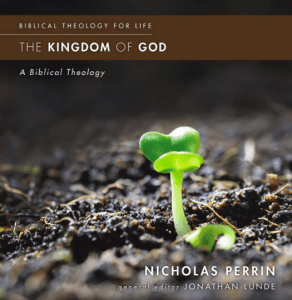 To talk kingdom is to talk king, the king’s rule, the king’s people, the king’s law/ethics and the king’s land. Nicholas Perrin discusses the king of the kingdom in his new book: The Kingdom of God: A Biblical Theology.
To talk kingdom is to talk king, the king’s rule, the king’s people, the king’s law/ethics and the king’s land. Nicholas Perrin discusses the king of the kingdom in his new book: The Kingdom of God: A Biblical Theology.
In other words, for Mark it is not merely a question of identity (Is Jesus the king or not?), but also a question of modality (If he is, what kind of king is he?) and functionality (If he is, what will he do?).
Perrin thinks to grasp the nature of this king and his rule you have to begin at the baptism. This is profoundly important. Too many want the king to rule and begin with a sword or, as is the case with too many progressives today, with judgment against injustice. Yes, we’ll get there but to grasp this king we begin as the Gospel of Mark does: at the baptism.
Who is he? Son of God. This means Psalm 2, 2 Samuel 22:20, Exodus 4:22-23 and then Exodus 2:10 — and Perrin sees behind Mark 1:11 “undertones of Exodus and Moses” (103). Add some Genesis 22 and Isaiah 42:1.
To summarize, in looking closely at the divine declaration at Jesus’s baptism, we see brief glimpses of David, Moses, and Isaac. As such, the baptism marks the moment where Jesus is being publicly announced as the messianic Son, a messianic Son who bears—like the wine at Cana—a distinctive, variegated, and complex character. Ascribing this kind of complexity to the baptismal voice should not be dismissed as inherently improbable. When you see someone flashing a V sign, you accept that a single hand signal can denote three different things (revolution, victory, and peace) simultaneously and without contradiction. At Jesus’s baptism, a single sentence spoken from heaven sheds light on Jesus’s vocation by invoking—simultaneously and without contradiction—three different story lines: the story of David, the story of Moses, and the story of Isaac. As it turns out, all three stories seem to be carried forward in the story of Jesus. The three stories together also seem to tell a tale—much like the V sign—of revolution, victory, and peace.
As the New David he is warrior-king, restorer of the tribes, and a sufferer.
As the New Moses he is redeemer and lawgiver.
As the New Isaac he is atonement and heir.
We get off on the wrong foot unless we make these kind of identity connections. His summary of it all — seven roles for Jesus:
First, leaning on the precedent set by David, Jesus presents himself as the ultimate warrior-king, who, though undertaking a style of warfare never seen before, would vanquish Israel’s real enemy, the Satan. Second, as the final inductee—after David and Solomon—into the order of the priest-king Melchizedek, Jesus comes to us as one destined to restore the scattered tribes from exile, so that one people may serve their one God in one place. Third, again like David, Jesus experiences considerable suffering; his sufferings are not incidental to his messianic vocation but are an essential component of it. Fourth, Mark’s readers learn that if up to that point in history Moses had been the redeemer of Israel, establishing the nation as a kingdom of priests, now that title and role fall to Jesus. Fifth, whereas Moses also provided the terms of kingdom life by issuing Torah, it is now Jesus, again as the new Moses, who not only issues a new law but also embodies it. Sixth, by reenacting the Aqedah of Isaac (with a major twist), Jesus reveals that dying for the sins of his people is also part of his kingly calling. Finally, as the Isaac-like heir, Jesus reveals that he stands to be heir of the eschatological fruitful vineyard. By extension, all of renewed creation falls to Jesus the king.











